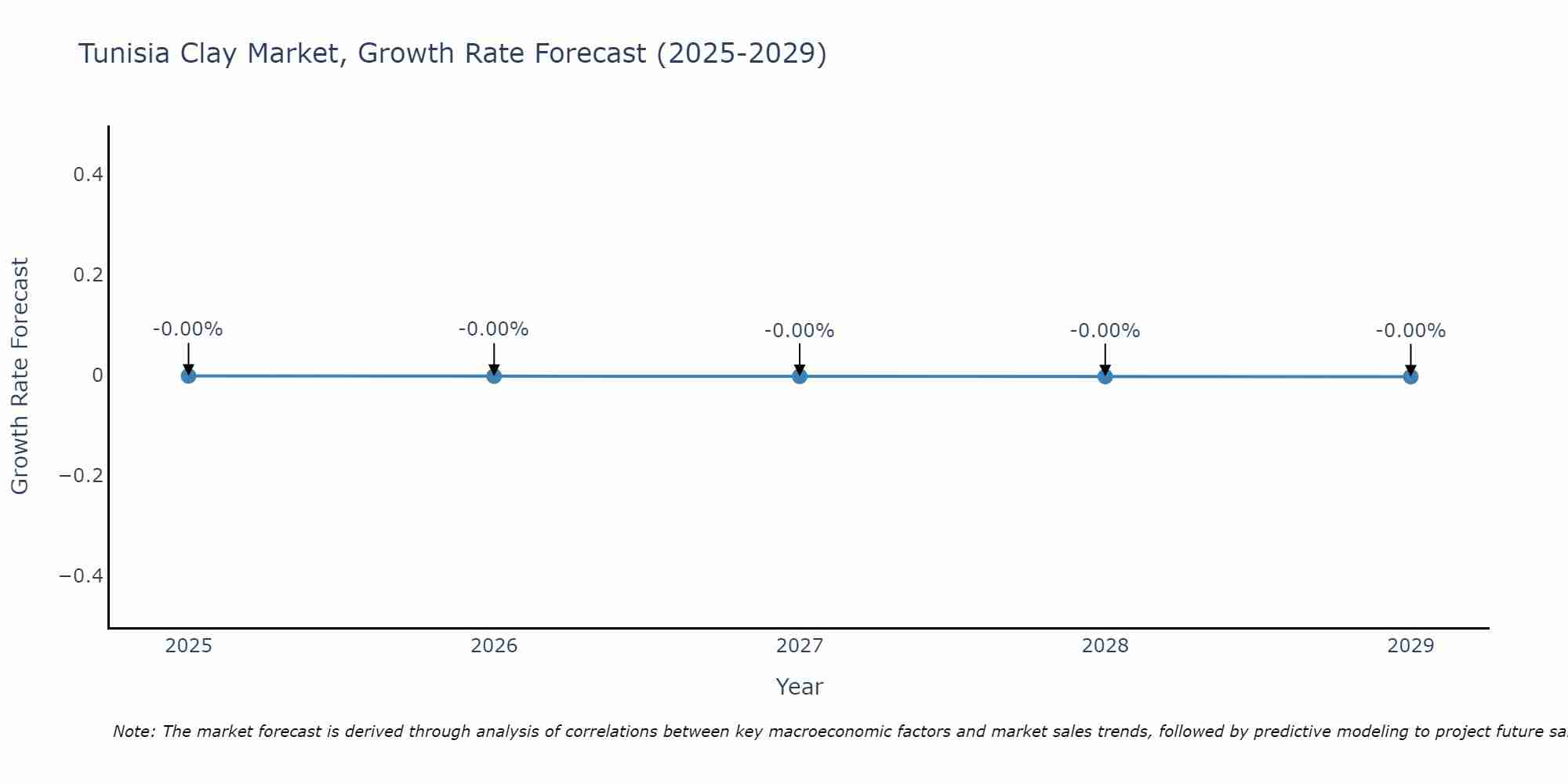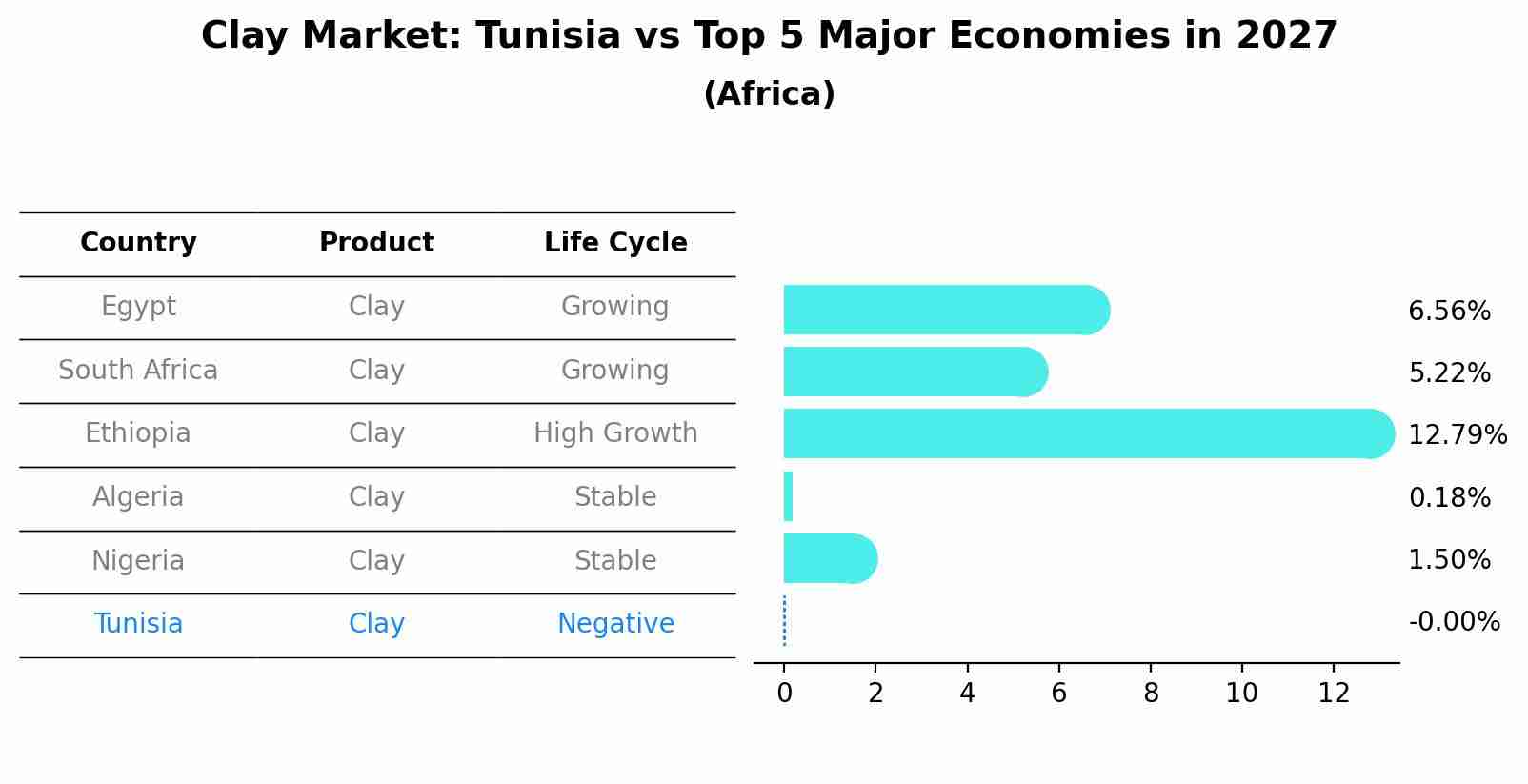Tunisia Clay Market Outlook | Companies, COVID-19 IMPACT, Share, Analysis, Value, Revenue, Trends, Industry, Growth, Size & Forecast
| Product Code: ETC319014 | Publication Date: Aug 2022 | Updated Date: Aug 2025 | Product Type: Market Research Report | |
| Publisher: 6Wresearch | Author: Shubham Padhi | No. of Pages: 75 | No. of Figures: 35 | No. of Tables: 20 |
Tunisia Clay Market Size Growth Rate
The Tunisia Clay Market could see a tapering of growth rates over 2025 to 2029. Although the growth rate starts strong at -0.00% in 2025, it steadily loses momentum, ending at -0.00% by 2029.

Clay Market: Tunisia vs Top 5 Major Economies in 2027 (Africa)
The Clay market in Tunisia is projected to grow at a negative growth rate of -0.00% by 2027, within the Africa region led by Egypt, along with other countries like South Africa, Ethiopia, Algeria and Nigeria, collectively shaping a dynamic and evolving market environment driven by innovation and increasing adoption of emerging technologies.

Tunisia Clay Market Overview
The clay market in Tunisia includes natural mineral clays used in ceramics, construction, and industrial applications for their plasticity, strength, and thermal resistance, supporting manufacturing, construction materials, and pottery industries.
Drivers of the market
The Tunisia Clay Market is propelled by its diverse applications in ceramics, construction materials, pharmaceuticals, and cosmetics. Clay minerals such as kaolin, bentonite, and montmorillonite are valued for their properties such as plasticity, binding ability, and absorption capacity. The growth of the construction industry, infrastructure development projects, and the increasing use of clays in skincare products significantly boost market demand. Technological advancements in clay processing and refinement techniques further support market expansion. Additionally, the rising environmental awareness and the shift towards sustainable clay mining practices enhance market growth.
Challenges of the market
Challenges in the Tunisia Clay Market include high production costs and competition from alternative materials. Additionally, there is limited domestic production capability and fluctuations in raw material availability.
Government Policy of the market
The Tunisian government supports the clay market through policies aimed at promoting sustainable mining practices, industrial applications, and environmental stewardship. Regulations ensure clay extraction permits, reclamation plans, and ecosystem preservation in mining operations. Incentives are provided for clay producers adopting resource-efficient technologies, waste management practices, and community development initiatives.
Key Highlights of the Report:
- Tunisia Clay Market Outlook
- Market Size of Tunisia Clay Market, 2024
- Forecast of Tunisia Clay Market, 2031
- Historical Data and Forecast of Tunisia Clay Revenues & Volume for the Period 2018 - 2031
- Tunisia Clay Market Trend Evolution
- Tunisia Clay Market Drivers and Challenges
- Tunisia Clay Price Trends
- Tunisia Clay Porter's Five Forces
- Tunisia Clay Industry Life Cycle
- Historical Data and Forecast of Tunisia Clay Market Revenues & Volume By Application for the Period 2018 - 2031
- Historical Data and Forecast of Tunisia Clay Market Revenues & Volume By Tableware for the Period 2018 - 2031
- Historical Data and Forecast of Tunisia Clay Market Revenues & Volume By Sanitary ware for the Period 2018 - 2031
- Historical Data and Forecast of Tunisia Clay Market Revenues & Volume By Medical applications for the Period 2018 - 2031
- Historical Data and Forecast of Tunisia Clay Market Revenues & Volume By End Use for the Period 2018 - 2031
- Historical Data and Forecast of Tunisia Clay Market Revenues & Volume By Ceramic and for the Period 2018 - 2031
- Historical Data and Forecast of Tunisia Clay Market Revenues & Volume By Non-ceramic for the Period 2018 - 2031
- Tunisia Clay Import Export Trade Statistics
- Market Opportunity Assessment By Application
- Market Opportunity Assessment By End Use
- Tunisia Clay Top Companies Market Share
- Tunisia Clay Competitive Benchmarking By Technical and Operational Parameters
- Tunisia Clay Company Profiles
- Tunisia Clay Key Strategic Recommendations
Frequently Asked Questions About the Market Study (FAQs):
1 Executive Summary |
2 Introduction |
2.1 Key Highlights of the Report |
2.2 Report Description |
2.3 Market Scope & Segmentation |
2.4 Research Methodology |
2.5 Assumptions |
3 Tunisia Clay Market Overview |
3.1 Tunisia Country Macro Economic Indicators |
3.2 Tunisia Clay Market Revenues & Volume, 2021 & 2031F |
3.3 Tunisia Clay Market - Industry Life Cycle |
3.4 Tunisia Clay Market - Porter's Five Forces |
3.5 Tunisia Clay Market Revenues & Volume Share, By Application, 2021 & 2031F |
3.6 Tunisia Clay Market Revenues & Volume Share, By End Use, 2021 & 2031F |
4 Tunisia Clay Market Dynamics |
4.1 Impact Analysis |
4.2 Market Drivers |
4.2.1 Increasing demand for clay in the construction industry due to urbanization and infrastructure development projects in Tunisia. |
4.2.2 Growing awareness about the benefits of using clay in sustainable building practices and its environmental-friendly nature. |
4.2.3 Rise in government initiatives promoting the use of locally sourced materials like clay to boost the domestic manufacturing sector. |
4.3 Market Restraints |
4.3.1 Fluctuations in raw material prices impacting the overall production costs of clay products. |
4.3.2 Intense competition from alternative building materials like concrete and steel, affecting the market share of clay products. |
4.3.3 Lack of technological advancements in the clay industry leading to inefficiencies in production processes and quality control. |
5 Tunisia Clay Market Trends |
6 Tunisia Clay Market, By Types |
6.1 Tunisia Clay Market, By Application |
6.1.1 Overview and Analysis |
6.1.2 Tunisia Clay Market Revenues & Volume, By Application, 2021-2031F |
6.1.3 Tunisia Clay Market Revenues & Volume, By Tableware, 2021-2031F |
6.1.4 Tunisia Clay Market Revenues & Volume, By Sanitary ware, 2021-2031F |
6.1.5 Tunisia Clay Market Revenues & Volume, By Medical applications, 2021-2031F |
6.2 Tunisia Clay Market, By End Use |
6.2.1 Overview and Analysis |
6.2.2 Tunisia Clay Market Revenues & Volume, By Ceramic and, 2021-2031F |
6.2.3 Tunisia Clay Market Revenues & Volume, By Non-ceramic, 2021-2031F |
7 Tunisia Clay Market Import-Export Trade Statistics |
7.1 Tunisia Clay Market Export to Major Countries |
7.2 Tunisia Clay Market Imports from Major Countries |
8 Tunisia Clay Market Key Performance Indicators |
8.1 Percentage increase in the number of construction projects incorporating clay products in Tunisia. |
8.2 Average lead time for clay product manufacturing and delivery to customers. |
8.3 Percentage reduction in carbon footprint achieved by using clay products compared to traditional building materials. |
8.4 Adoption rate of sustainable building certifications (e.g., LEED) for projects using clay products. |
8.5 Rate of investment in research and development initiatives to enhance clay product quality and production efficiency. |
9 Tunisia Clay Market - Opportunity Assessment |
9.1 Tunisia Clay Market Opportunity Assessment, By Application, 2021 & 2031F |
9.2 Tunisia Clay Market Opportunity Assessment, By End Use, 2021 & 2031F |
10 Tunisia Clay Market - Competitive Landscape |
10.1 Tunisia Clay Market Revenue Share, By Companies, 2024 |
10.2 Tunisia Clay Market Competitive Benchmarking, By Operating and Technical Parameters |
11 Company Profiles |
12 Recommendations |
13 Disclaimer |
- Single User License$ 1,995
- Department License$ 2,400
- Site License$ 3,120
- Global License$ 3,795
Search
Related Reports
- ASEAN Bearings Market (2025-2031) | Strategy, Consumer Insights, Analysis, Investment Trends, Opportunities, Growth, Size, Share, Industry, Revenue, Segments, Value, Segmentation, Supply, Forecast, Restraints, Outlook, Competition, Drivers, Trends, Demand, Pricing Analysis, Competitive, Strategic Insights, Companies, Challenges
- Europe Flooring Market (2025-2031) | Outlook, Share, Industry, Trends, Forecast, Companies, Revenue, Size, Analysis, Growth & Value
- Saudi Arabia Manlift Market (2025-2031) | Outlook, Size, Growth, Trends, Companies, Industry, Revenue, Value, Share, Forecast & Analysis
- Uganda Excavator, Crane, and Wheel Loaders Market (2025-2031) | Strategy, Consumer Insights, Analysis, Investment Trends, Opportunities, Growth, Size, Share, Industry, Revenue, Segments, Value, Segmentation, Supply, Forecast, Restraints, Outlook, Competition, Drivers, Trends, Demand, Pricing Analysis, Competitive, Strategic Insights, Companies, Challenges
- Rwanda Excavator, Crane, and Wheel Loaders Market (2025-2031) | Strategy, Consumer Insights, Analysis, Investment Trends, Opportunities, Growth, Size, Share, Industry, Revenue, Segments, Value, Segmentation, Supply, Forecast, Restraints, Outlook, Competition, Drivers, Trends, Demand, Pricing Analysis, Competitive, Strategic Insights, Companies, Challenges
- Kenya Excavator, Crane, and Wheel Loaders Market (2025-2031) | Strategy, Consumer Insights, Analysis, Investment Trends, Opportunities, Growth, Size, Share, Industry, Revenue, Segments, Value, Segmentation, Supply, Forecast, Restraints, Outlook, Competition, Drivers, Trends, Demand, Pricing Analysis, Competitive, Strategic Insights, Companies, Challenges
- Angola Excavator, Crane, and Wheel Loaders Market (2025-2031) | Strategy, Consumer Insights, Analysis, Investment Trends, Opportunities, Growth, Size, Share, Industry, Revenue, Segments, Value, Segmentation, Supply, Forecast, Restraints, Outlook, Competition, Drivers, Trends, Demand, Pricing Analysis, Competitive, Strategic Insights, Companies, Challenges
- Israel Intelligent Transport System Market (2025-2031) | Strategy, Consumer Insights, Analysis, Investment Trends, Opportunities, Growth, Size, Share, Industry, Revenue, Segments, Value, Segmentation, Supply, Forecast, Restraints, Outlook, Competition, Drivers, Trends, Demand, Pricing Analysis, Competitive, Strategic Insights, Companies, Challenges
- Uganda Precast and Aggregate Market (2025-2031) | Strategy, Consumer Insights, Analysis, Investment Trends, Opportunities, Growth, Size, Share, Industry, Revenue, Segments, Value, Segmentation, Supply, Forecast, Restraints, Outlook, Competition, Drivers, Trends, Demand, Pricing Analysis, Competitive, Strategic Insights, Companies, Challenges
- Australia IT Asset Disposal Market (2025-2031) | Strategy, Consumer Insights, Analysis, Investment Trends, Opportunities, Growth, Size, Share, Industry, Revenue, Segments, Value, Segmentation, Supply, Forecast, Restraints, Outlook, Competition, Drivers, Trends, Demand, Pricing Analysis, Competitive, Strategic Insights, Companies, Challenges
Industry Events and Analyst Meet
Our Clients
Whitepaper
- Middle East & Africa Commercial Security Market Click here to view more.
- Middle East & Africa Fire Safety Systems & Equipment Market Click here to view more.
- GCC Drone Market Click here to view more.
- Middle East Lighting Fixture Market Click here to view more.
- GCC Physical & Perimeter Security Market Click here to view more.
6WResearch In News
- Doha a strategic location for EV manufacturing hub: IPA Qatar
- Demand for luxury TVs surging in the GCC, says Samsung
- Empowering Growth: The Thriving Journey of Bangladesh’s Cable Industry
- Demand for luxury TVs surging in the GCC, says Samsung
- Video call with a traditional healer? Once unthinkable, it’s now common in South Africa
- Intelligent Buildings To Smooth GCC’s Path To Net Zero













